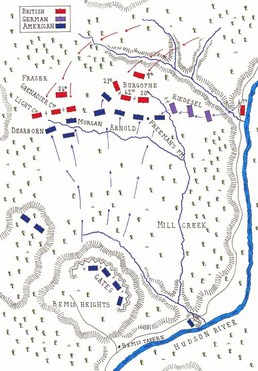Colonists (Number of Soldiers)
9,000 (first battle)
over 12,000 (second battle)
over 15,000 (at time of surrender)
Leaders:
Horatio Gates
Benedict Arnold
Benjamin Lincoln
Enoch Poor
Ebenezer Learned
Daniel Morgan
Causalities:
90 killed
240 wounded
over 12,000 (second battle)
over 15,000 (at time of surrender)
Leaders:
Horatio Gates
Benedict Arnold
Benjamin Lincoln
Enoch Poor
Ebenezer Learned
Daniel Morgan
Causalities:
90 killed
240 wounded
Great Britain (Number of Soldiers)
7,200 (first battle)
6,600 (second battle)
Leaders:
John Burgoyne
Simon Fraser
F.A. Riedesel
Johann Specht
Wilhelm R. von Gall
Causalities:
440 killed
695 wounded
6,222 captured
6,600 (second battle)
Leaders:
John Burgoyne
Simon Fraser
F.A. Riedesel
Johann Specht
Wilhelm R. von Gall
Causalities:
440 killed
695 wounded
6,222 captured
The Battle

1st Battle of Saratoga (September 19)
The Battles of Saratoga occurred on both September 19 and October 7, 1777, both of which conclusively decided the fate of British General John Burgoyne's army in the American Revolutionary War and they are generally regarded as a turning point in the war. The battles were fought eighteen days apart on the same ground, 9 miles (14 km) south of Saratoga, New York. Burgoyne, whose campaign to divide New England from the southern colonies had started well, but slowed due to logistical problems, won a small tactical victory over General Horatio Gates and the Continental Army in the September 19 Battle of Freeman's Farm at the cost of significant casualties. His gains were erased when he again attacked the Americans in the October 7 Battle of Bemis Heights and the Americans captured a portion of the British defenses. Burgoyne was therefore compelled to retreat, and his army was surrounded by the much larger American force at Saratoga, forcing him to surrender on October 17. News of Burgoyne's surrender was instrumental in formally bringing France into the war as an American ally, having previously given supplies, ammunition and guns, notably the de Valliere cannon, which played an important role in Saratoga. French formal participation changed the war to a global conflict. This battle also resulted in Spain contributing to the war on the American side.
The first battle, on September 19, began when Burgoyne moved some of his troops in an attempt to flank the entrenched American position on Bemis Heights. Benedict Arnold, anticipating the maneuver, placed significant forces in his way. While Burgoyne succeeded in gaining control of Freeman's Farm, it came at the cost of significant casualties. Skirmishing continued in the days following the battle, while Burgoyne waited in the hope that reinforcements would arrive from New York City. Militia forces continued to arrive, swelling the size of the American army. Disputes within the American camp led Gates to strip Arnold of his command.
Concurrent with the first battle, American troops also attacked British positions in the area of Fort Ticonderoga, and bombarded the fort for a few days before withdrawing. British General Sir Henry Clinton, in an attempt to divert American attention from Burgoyne, captured American forts in the Hudson River highlands on October 6, but his efforts were too late to help Burgoyne. Burgoyne attacked Bemis Heights again on October 7 after it became apparent he would not receive relieving aid in time. In heavy fighting, marked by Arnold's spirited rallying of the American troops (in open defiance of orders to stay off the battlefield), Burgoyne's forces were thrown back to the positions they held before the September 19 battle and the Americans captured a portion of the entrenched British defenses.
The first battle, on September 19, began when Burgoyne moved some of his troops in an attempt to flank the entrenched American position on Bemis Heights. Benedict Arnold, anticipating the maneuver, placed significant forces in his way. While Burgoyne succeeded in gaining control of Freeman's Farm, it came at the cost of significant casualties. Skirmishing continued in the days following the battle, while Burgoyne waited in the hope that reinforcements would arrive from New York City. Militia forces continued to arrive, swelling the size of the American army. Disputes within the American camp led Gates to strip Arnold of his command.
Concurrent with the first battle, American troops also attacked British positions in the area of Fort Ticonderoga, and bombarded the fort for a few days before withdrawing. British General Sir Henry Clinton, in an attempt to divert American attention from Burgoyne, captured American forts in the Hudson River highlands on October 6, but his efforts were too late to help Burgoyne. Burgoyne attacked Bemis Heights again on October 7 after it became apparent he would not receive relieving aid in time. In heavy fighting, marked by Arnold's spirited rallying of the American troops (in open defiance of orders to stay off the battlefield), Burgoyne's forces were thrown back to the positions they held before the September 19 battle and the Americans captured a portion of the entrenched British defenses.
